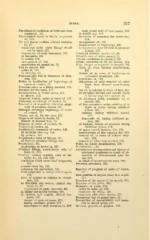Page 469 - My FlipBook
P. 469
317
Physiological conditions of teeth and bone open apical ends of root canals, 275.
compared, 191. in middle age, 217.
Physiological repair in dentin, no process limitation of extension for prevention,
of, 128. 214.
Pit and fissure cavities, clinical features, management of, 208.
92, 97. misplacement of beginnings, 100.
conditions under which fillings should prophvlactice value of form in proximal
not be made, 207. fillings, 222.
importance of early treatment, 207. Proximal surfaces, erosion of, 49.
in bicuspids, 206. Prunty's case of white enamel, 31.
in molars, 204. Psychic conditions in patients, 153.
management of, 204. Public, education of, by the dentist, 154.
penetration of enamel in, 76. Pulp, danger of exposure in atrophy, 21.
Pits in enamel, 124. death of, from thermal sensitiveness,
caries in, 124. 152.
in atrophy, 30. disease of, as cause of tenderness of
Platinum-gold foil in treatment of abra- peridental membrane, 169.
sion, 201. hyperemia of, 184.
Points in localization of beginnings of importance of early removal of, after
caries of enamel, 75. death from thermal sensitiveness,
Porcelain inlay as a filling material, 201. 152.
Powders for the teeth, 157. loss of, in relation to force of bite, 162.
Predisposition to dental caries, 115. of atrophied incisors and cuspids closer
to disease, 115. to incisal edge than normal, 26.
Pregnant women, caries in teeth of, 117. of deciduous teeth, proximity of, to
Preiswerk, re etiology of erosion, 56. enamel, 256.
Prevention of secondary extension gingi- of first permanent molar, relation of to
vally of proximal decays, 102. depth of decay, during childhood
Principle governing beginnings of caries period, 267.
of enamel, 75. capping, during childhood period,
Prisms, use of, for the eyes, 177. 270.
Progress of caries in dentin, 69. hyperemia of, during childhood pe-
limited or stopped how, 72. riod, 269.
Progress of caries of enamel, 76. of incisors, danger of exposure during
Progress of erosion, 42. childhood period, 273.
Prophylactic treatment of caries, 143. of upper lateral incisors, 274, 276.
by artificial cleaning, 18S. oxyphosphate of zinc capping for, 206.
by patient, 182. removal of, in cases of delayed erup-
Prophylactic value of fillings, 194. tion, 261.
of form in proximal fillings, 222. removal of, often bad practice, 276.
Prophylaxis, 154. Pulse, in dental examinations, 178.
mastication as factor in, 167. Putrefaction, 141.
Proximal fillings, prophylactic value of Putrefactive decomposition and disease of
form in, 222. peridental membrane as result of ab-
Proximal surface cavities, area of lia- sorption of interproximal gum tis-
bility, 81, 85, 113, 210. sue, 103.
conditions which cause food lodgments, as result of interproximal wear, 106.
102. Pyorrhea alveolaris, 186.
examinations for, 181.
extension for prevention, 211. Rapidity of progress of caries of dentin,
food lodgments in interproximal space, 72.
220. Rare position of lingual decay in a cuspid,
form of surface in relation to cleanli- 112.
ness, 219. Reaction of the mucus of the mouth, 132.
in bicuspids and molars, clinical fea- Reaction of the saliva, 132.
tures, 93, 97. Recession of gums, 186.
importance of early discovery, 98. caries in eases of, 230.
in highly susceptible persons, 215. treatment by filling, 231.
in incisors and cuspids, clinical fea- treatment with silver nitrate, 231.
tures, 107. Recessional line of pulpal horn, 95.
danger of pulp exposure, 273. Recognition of susceptibility and immu-
during childhood period, 272. nity to dental caries, 137.
importance of early attention to, 109. Redness, general, of gingiva?, 185.


